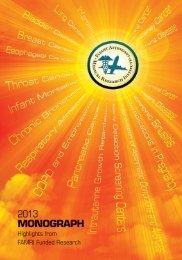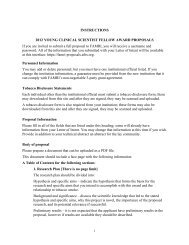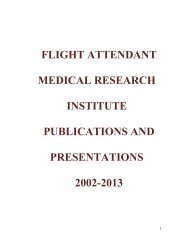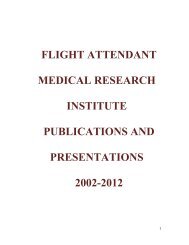MISSION
2009 compendium of FAMRI-supported research - Flight Attendant ...
2009 compendium of FAMRI-supported research - Flight Attendant ...
You also want an ePaper? Increase the reach of your titles
YUMPU automatically turns print PDFs into web optimized ePapers that Google loves.
prostaglandin E2 in non-small-cell lung cancer cells by up-regulating 15-hydroxyprostaglandin<br />
dehydrogenase. Mol Pharmacol 2007;71:1715-20.<br />
Hazra S, Dubinett SM. Ciglitazone mediates COX-2 dependent suppression of PGE2 in human non-small<br />
cell lung cancer cells. Prostaglandins Leukot Essent Fatty Acids 2007;77:51-8.<br />
Hazra S, Kostyantyn K, Walser T, Gardner B, Lee G, Shay J, Minna J, Horvath S, Dubinett S. A systems<br />
approach to the preclinical evaluation of targeted chemoprevention for lung cancer. Cancer Prevention<br />
Research 1 (7 Supplement), A136, November 1, 2008).<br />
CANCER, LUNG<br />
COMPLETED RESEARCH<br />
METHYLATION ANALYSIS OF LUNG CANCERS FROM SMOKING AND NON-SMOKING WOMEN<br />
William P. Bennett, MD, MS; City of Hope; CIA 2004<br />
Tobacco carcinogens cause distinctive mutations in lung cancers. For example, the p53 “mutation<br />
signature” can discriminate groups of tumors from smokers and non-smokers, but it cannot classify<br />
individual tumors effectively, because informative mutations are sparse. Epigenetic changes occur more<br />
frequently than mutations, so Dr. Bennett and colleagues developed a “methylation signature” of<br />
incinerated tobacco.<br />
The group accomplished this goal by isolating genomic DNA from formalin-fixed, paraffin-embedded<br />
tissues, which was subsequently subjected to bisulfite modification, which converts unmethylated cytosines<br />
to uracils. Segments of CpG islands were amplified by PCR, and methylation was quantified by mass<br />
spectrometry (www.sequenom.com). The two principal advantages over other technologies were: 1)<br />
increased efficiency because many CpG sites are interrogated within a single PCR product; and 2)<br />
quantitative assessments because the methylated and unmethylated forms of a single CpG site are separated<br />
by mass differences that can be measured by mass spectrometry.<br />
The group analyzed the methylation status of 27 CpG units in promoter regions of the following genes:<br />
CDH13, p16/CDKN2A, and RassF1A from 30 smokers and 8 non-smokers. They found that: 1) 12 of<br />
30 (40%) tumors from smokers have more methylation in p16/CDKN2A and RassF1A than any of the<br />
eight non-smokers; 2) smokers have more moderate to high-level (30-100%) methylation than nonsmokers<br />
in p16/CDKN2A and RassF1A; 3) non-smokers have more low-level (1-10%) methylation than<br />
smokers; and 4) smokers and non-smokers have comparable amounts of methylation in CDH13.<br />
By developing a robust “tobacco signature” based on methylation rates at hotspot CpG sites lung<br />
cancers in non-smokers caused by exposure to SHS will be more readily identified.<br />
FAMRI Supported Publications<br />
Bennett, WP, Larson G, Xiong W, Rivas G, Kernstine KH, Pfeifer GP. Methylation analysis of lung cancers<br />
from smoking and non-smoking women. Proc Am Assoc for Cancer Res 2008;49:7.<br />
TGF BETA SIGNALING IN LUNG CANCER: A THERAPEUTIC TARGET<br />
Pran Datta, PhD; Vanderbilt University; CIA 2005<br />
Dr. Datta’s hypothesis stated that loss of transforming growth factor-beta receptor type II (TGF<br />
betaRII) in NSCLC and SCLC is primarily due to the epigenetic change, histone deacetylation. This<br />
promotes unresponsiveness to transforming growth factor-beta (TGF- beta)-induced tumor suppressive<br />
effects, and restoration of this signaling may be a potential alternative or addition to radiation as a lung<br />
cancer treatment. The aims of the study were: 1) to determine the molecular mechanism of TGF beta RII<br />
downregulation in primary lung cancer; 2) to determine if restoration of TGF beta signaling re-establishes<br />
tumor suppressor function or tumor-promoting effects of TGF beta; and 3) to investigate the radiationsensitizing<br />
effects of the histone deacetylase inhibitor MS-275 in vitro and in vivo in human lung cancer<br />
preclinical models. Thus far, they have observed that TGF-beta-induced tumor suppressor function is<br />
restored in TGF beta-resistant lung cancer cells either by exogenous expression of TGF betaRII or by the<br />
treatment with histone deacetylase inhibitors (HDI). Dr. Datta’s group has identified a region of the TGF<br />
betaRII promoter required for its activation by HDI and proteins that are involved in the regulation of<br />
TGF betaRII expression using proteomics and biochemical methods.<br />
FAMRI Supported Publications<br />
Anumanthan G, Halder SK, Friedman D, Datta PK. Oncogenic STRAP modulates the function of Ewing<br />
1 1 8 P A G E







